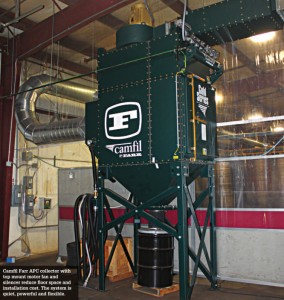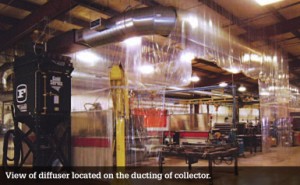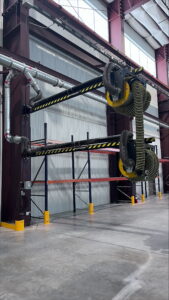The workplace atmosphere plays a large role in the overall manufacturing process. In step with workers’ well-being in mind—and a boost to morale—a clean and efficient workplace can make a positive impact on the bottom line. But changes in production volume or configuration can upset even the most carefully planned shop.
Serving the lawn and garden industry, General Sheet Metal Works also fabricates parts for the solar industry, working primarily with mild steel. The company supplies OEMs that sell products.
The majority of its orders call for 1/2 in. plate and under. “We’ll do it all,” says Jeff Zelley, plant manager at General Sheet Metal Works Inc. in Tomah, Wis. He says the
company frequently welds 16-gauge through 1/2 in. plate, but has the capability to work with thicker materials as well.
 “The welding in our shop increased and we were doing more welding than we had in the past so we started running more welding booths on multiple shifts,” Zelley says. “We needed something that would ensure we were cleaning any contaminants we were generating, not only to create a better work environment, but so we weren’t polluting the air.”
“The welding in our shop increased and we were doing more welding than we had in the past so we started running more welding booths on multiple shifts,” Zelley says. “We needed something that would ensure we were cleaning any contaminants we were generating, not only to create a better work environment, but so we weren’t polluting the air.”
Requirements Checklist
General Sheet Metal Works is broken down into different departments. One area contains welding stations and another area contains milling and drilling stations.Workers in other departments do not want to inhale smoke from welding stations.
Among multiple welding stations in the department, one robotic welding cell produces a higher dust load, volume of welding fumes and smoke per hour than the manual stations in the area. “It allows us the flexibility to work anywhere in that booth or in the weld shop,” Zelley says. “We have a very diverse product mix—we are a contract manufacturer. In a lot of ways, we may not know what we’re going to be welding tomorrow or next week, so we needed flexibility within our weld shop to use a variety of different weld fixtures.”
Mississippi Welders Supply (MWS) in LaCrosse,Wis., which is a dealer for Glacier Technology, Plymouth, Minn., referred General Sheet Metal Works to an air filtration system from Camfil Farr Air Pollution Control, Jonesboro, Ark. The exclusive representative in Western Wisconsin, Glacier Technology worked with General Sheet Metal Works, selecting the Gold SeriesGS6 cartridge dust and fume collector with six HemiPleat filter elements system and 7,000 cfm.
“General Sheet Metal Works’ objectives were clear: to protect the breathing zones for welders, contain smoke in the welding area, keeping the area cleaner and reducing welding smoke exposure to other manufacturing departments,” says Greg Schreier, metalworking market manager for Camfil Farr APC.
After listening to what Zelley needed, Schreier drove to the plant in Wisconsin with another contractor to diagnose the problem and plan a two to four month time frame for completion. “Instead of using a source capture application monitored and controlled by an operator to make sure airflow is being distributed properly, Camfil Farr APC’s ambient system filters the air in the entire welding department,” Zelley explains. The air filtration system captures all the materials within each work area and redirects some of the filtered air back into the shop.
According to Camfil Farr APC, the filter cartridges use fire-retardant filtration media that delivers a minimum of 99.99 percent removal efficiency down to 0.5 micron by weight, ideal for handling welding fumes. Made mostly from 7-gauge carbon steel, the module has a 10-gauge door, hopper, inlet and panels. The verticallymounted cartridge design eliminates dust containment problems. Unlike standard horizontal cartridge surfaces, which tend to collect dust on the surfaces, the vertically-mounted cartridge design does not.
 TheHemiPleat filter cartridge’s patented open pleat configuration is a departure from conventional dust collection system filters on the market. The spacing of the pleating allows for better use of the filtration system’s media pack, allowing for better airflow through the cartridge. According to the company, dust also releases more easily during the pulse cleaning process, reducing air requirements. Using air downstream instead of ambient air for the collector is both cleaner and more energy efficient.
TheHemiPleat filter cartridge’s patented open pleat configuration is a departure from conventional dust collection system filters on the market. The spacing of the pleating allows for better use of the filtration system’s media pack, allowing for better airflow through the cartridge. According to the company, dust also releases more easily during the pulse cleaning process, reducing air requirements. Using air downstream instead of ambient air for the collector is both cleaner and more energy efficient.
Camfil Farr APC complies with American Conference of Governmental Industrial Hygienists (ACGIH) ventilation practices and tests its systems for dust loading based on ceiling height and number of operators. “We’re very particular about uncovering customer pain and [what] components they want. We then custom engineer a system that really meets their production needs,” Schreier says.
Added Benefits
The automatic, reliable and powerful air filtration system from Camfil Farr APC is also easy to adjust as shop layouts change and welding stations are added or rearranged. Customers can adjust the air flow for the exhaust pulling dirty air out and filtering clean air into the shop without complicated rearranging of welding stations.
General Sheet Metal Works also installed containment curtains to direct airflow so welding smoke moves toward the collectors and away from welders.
Air moves from high pressure into low pressure areas. By exhausting some air outside the curtained area, “we create a high pressure area outside the curtain and a low pressure area inside,” Schreier explains. Air naturally moves into the curtained area, containing all weld smoke as it moves.
Once the contaminated air is filtered through the system, the air is filtered again before going back through the plant, according to Camfil Farr APC. A discharge silencer is used on the collector fan, making air filtration a quieter process. “So we designed the system to provide more clean air into the area that [generates] more smoke,” Schreier says. “We also did a custom ducting layout for the clean air going in and the dirty air leaving the facility.”
Zelley wanted to be able to filter the air throughout the shop well enough that it could be reused, “and this system does that,” Zelley says.
“We’re not pumping all that heated air out of the building, it’s being filtered and pumped back into the work areas, which saves on both heating and utility costs,” he adds.
 Once the filtration system was installed, Zelley says the shop immediately felt cleaner. “You could see the welding fumes moving up and away from working areas,” he says, adding the Camfil Farr APC system allows welding stations to be located anywhere within the shop.
Once the filtration system was installed, Zelley says the shop immediately felt cleaner. “You could see the welding fumes moving up and away from working areas,” he says, adding the Camfil Farr APC system allows welding stations to be located anywhere within the shop.
“Nobody wants to come to work in a dingy, dirty environment,” Zelley says. “If the shop is clean and the air is clean, employees are happier to come into work and therefore are more productive. It’s easier for them to take pride in their work when they’re proud of their environment and comfortable going in to their workspace every day.”

 Case Study: Innovative Welding Fume Control in a State-of-the-Art Manufacturing Facility
Case Study: Innovative Welding Fume Control in a State-of-the-Art Manufacturing Facility